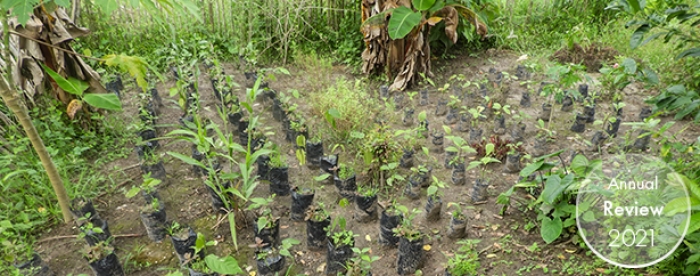News
Our stories ... ...

Colombia - 27 June, 2022
For several years, Tropenbos Colombia has been promoting participatory productive restoration (PPR) as an alternative to top-down restoration projects. After taking root in 2020, PPR really started growing in 2021. More than 100 initiatives are now up and running, and enthusiasm for PPR is spreading.
To achieve its ambitious tree-planting targets, the Government of Colombia focuses on large-scale planting of a limited number of tree species. According to Tropenbos Colombia, these top-down tree-planting projects have some serious shortcomings, as they do not result in resilient ecosystems, and neither do they involve or benefit local communities. Moreover, the government-led efforts focus on planting as many seedlings as possible to reach national targets, but pay little attention to the question of who will maintain the seedlings to make sure they grow into adult trees.
Recognizing these flaws, Tropenbos Colombia has been advocating for an alternative, bottom-up approach to the restoration of degraded lands, where the focus is not only on planting but also on growing the trees. This approach — known as participatory productive restoration (PPR) — is led by local people and is based on their own needs and their knowledge of the environment. The approach provides access to timber, fruits and firewood, and helps to retain water, supporting healthy and resilient ecosystems.
In 2020, Tropenbos Colombia started actively promoting PPR in the Solano landscape in the southern department of Caquetá. They invited Indigenous and peasant farmers to develop proposals for small-scale restoration initiatives. Tropenbos Colombia would then provide technical assistance and a small budget for these initiatives, for example to purchase seedings and fencing materials for restoration plots. By the end of 2020, three restoration plots had been established. By the end of 2021, more than one hundred local initiatives were up and running. Each of them is unique, and is customized to the specific ecological context in terms of soils and degradation levels, and to specific local needs and priorities, such as the protection of water bodies.
All over the Solano landscape are formerly deforested plots coming back to life. People are enthusiastic. In an effort to further mainstream locally led restoration, representatives of Indigenous and peasant communities in Solano have proposed that PPR be included as a special category in the upcoming revision of the municipality’s spatial plan. Also, inspired by Tropenbos Colombia, several other NGOs want to start supporting farmers to develop and implement their own restoration initiatives. And, after discussions with Tropenbos Colombia, Visión Amazonía — a large government programme to reduce deforestation — started looking into the possibility of including PPR in its strategy for the deforested parts of the Amazon basin.
In the long term, PPR is much more sustainable than the large-scale tree planting projects of the government. Crucially, it starts with the Indigenous people and peasants themselves, who are invested in its long-term success. This is key to ensuring that tree-planting efforts will ultimately lead to a restored landscape, contributing simultaneously to climate, biodiversity and livelihood objectives.

due for release in July 2022